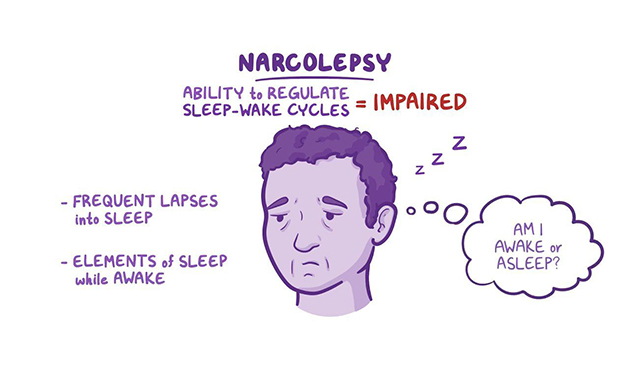Narcolepsy is a sleep disorder that makes people feel sleepy the whole day. This disorder won’t let the patient stay awake for long periods. The patients can sleep suddenly, and this causes serious problems in daily life. Narcolepsy can also cause a sudden loss of muscle tone, known as cataplexy. This can trigger strong emotions, especially laughter.
There are two types of narcolepsy. Most people with type 1 narcolepsy have cataplexy, and people without cataplexy have narcolepsy type 2. It’s a life-long complication, and it has no cure. However, narcolepsy medication and lifestyle modifications can help manage the symptoms, and support from family, friends, employers, and teachers can help people with this disorder. Narcolepsy 2 and 1 are both chronic neurological disorders and clinical syndromes of hypothalamic disorder. The exact cause of the disorder is unknown.
Narcolepsy Causes
As mentioned above, the exact cause is unknown, and several distinct factors may cause it. In this disease, the loss of orexin-releasing neurons within the lateral hypothalamus happens. Some researchers have described that people with type 1 narcolepsy have lower levels of orexin, and orexin is a chemical that helps in the regulation of wakefulness and REM sleep. There are great chances of the onset of this disorder in a patient if there is a family history of the disorder. Narcolepsy with cataplexy is more common in family history.
Narcolepsy Symptoms
Narcolepsy symptoms worsen during the initial phase, but they continue for life after that. Some of the narcolepsy symptoms in adults are as follows:
-
- Excessive sleepiness during daytime – Patients with narcolepsy disorder fall asleep without warning, and it happens anywhere and at any time. This is very dangerous as patients can fall asleep even while driving. The patient can fall asleep for only a few minutes or up to a half-hour, and after waking, the patient will often feel refreshed, but the patient gets sleep again. Some patients with acute narcolepsy continue doing a task during sleep and also for a brief period.
- Sudden loss of muscle tone – Also known as catalepsy, it occurs in type 1 narcolepsy. It causes slurred speech or complete weakness of most muscles. Signs and symptoms may last up to a few minutes. And it can’t be controlled and is triggered by intense emotions. For instance, when you laugh, your head may drop without control, or your knees may suddenly lose strength, causing you to fall. Most of the people experience cataplexy symptoms once or twice a year.
- Sleep paralysis – During sleep paralysis, the patient can’t move or speak while falling asleep or upon waking. It happens for a brief period but is very scary. Sleep paralysis can happen without narcolepsy also.
- Hallucinations – Hallucinations happen during sleep paralysis, and they may happen in bed without sleep paralysis. The patient imagines things that are not present. If hallucinations happen upon walking, then it is known as hypnopompic hallucinations. These hallucinations are vivid and scary because the patient may not be fully asleep when the patient begins dreaming.
- Changes in REM sleep – Rapid eye movement (REM) sleep is when most dreaming happens. People enter into REM sleep after 60 to 90 minutes, and patients with narcolepsy quickly move to REM sleep.
Narcolepsy Diagnosis
Your physicians can detect the symptoms of acute narcolepsy, and they mainly examine symptoms of excessive sleepiness in the daytime and a sudden loss of muscle tone, referred to as cataplexy. Visit a sleep specialist if you ever feel that you have narcolepsy and get a formal diagnosis. During formal diagnosis, the patient is observed overnight at a sleep center for an in-depth analysis. Severity is diagnosed based on the following factors:
-
- Sleep history
- Sleep records
- Sleep study, known as polysomnography – is a test that measures signals during sleep using flat metal discs called electrodes placed on your scalp. The patient must spend a night at a medical facility during this test. The test measures brain waves, heart rate, and breathing. It also records your leg and eye movements.
- Genetic tests – sometimes, a genetic test is performed to see if you are at risk of type 1 narcolepsy.
Treatment
There are no permanent cures for narcolepsy, but lifestyle changes and narcolepsy treatment options can help manage the symptoms.
Narcolepsy medication options are given below:
-
- Stimulants are drugs that stimulate the central nervous system and keep the patients awake during the day. Your physicians may refer to Provigil and Nuvigil. Solriamfetol and Pitolisant are narcolepsy medicines that help in the management of narcolepsy with cataplexy.
- Serotonin and norepinephrine reuptake inhibitors or selective serotonin reuptake inhibitors are drugs for narcolepsy that help suppress REM sleep.
- Tricyclic antidepressants – these are the meds for narcolepsy used to treat cataplexy. Some side effects include dry mouth or light-headedness, so take these medications after consulting the doctor.
There are several other forms of narcolepsy therapies available to manage the symptoms of narcolepsy. There are also new medicines for narcolepsy; consult your healthcare professional to know about them.
Lifestyle and home remedies
Other narcolepsy treatments include the following:
-
- Take short naps – take short naps during the day at short regular intervals.
- Stick to a schedule – Make sure you sleep and wake up at the same time daily, including weekends.
- Regular exercise – plan for moderate, regular exercise at least 4 to 5 hours before bedtime; this helps the patient sleep better at night and feel more awake during the day.




